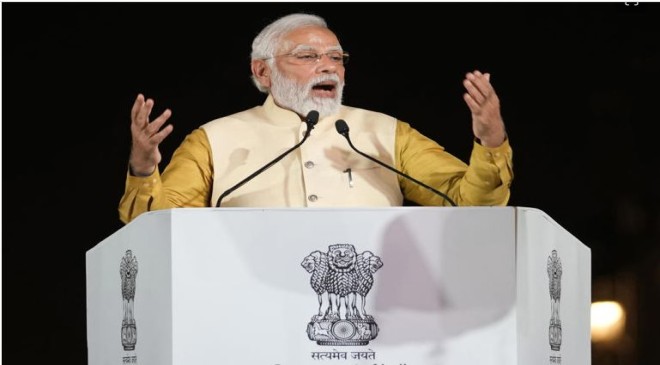Indian Prime Minister Narendra Modi has inaugurated a new parliament building in New Delhi in a grand ceremony boycotted by more than a dozen opposition parties.
Modi opened the new parliament house, which he called “a cradle of empowerment”, on Sunday by offering prayers as Hindu priests chanted religious hymns at the start of the ceremony.
Also Read– 5 Reasons (As in Weapons) The U.S. Army Can’t Be Beat in A War
“The new parliament isn’t just a building; it is the symbol of the aspiration of the 140 crore [1.4 billion] people of India,” Modi said in an address after the inauguration, which comes a year before parliamentary elections in the world’s most populous nation and as Modi’s Bharatiya Janata Party (BJP) seeks a third term in office.
“This new complex will be evidence of self-reliant India,” he said.
The new parliament building is part of plan by Modi’s Hindu nationalist government to revamp British colonial-era architecture, including the old parliament building, which will likely be converted into a museum.
Read More : Google wants to pay you for finding security flaws in its biggest Android apps
Opposition parties criticised the event, saying the prime minister had sidelined President Droupadi Murmu, who has only ceremonial powers but is the head of state and highest constitutional authority.
‘Insult’ to India’s democracy
Modi’s “decision to inaugurate the building by himself” was “a grave insult” to India’s democracy, opposition parties said in a statement on Wednesday, adding that the government had “disqualified, suspended and muted” opposition lawmakers while passing “controversial legislation” with little debate.
“When the soul of democracy has been sucked out from the parliament, we find no value in a new building,” the parties said.
“To open a new parliament building without the opposition, it does not mean there is a democracy in the country. It’s an incomplete event,” Supriya Sule, an opposition leader, told the ANI news agency.
Read More : Gas prices today: Where to find the cheapest fuel across the country
The Modi government has rejected the opposition argument, saying no protocol has been violated and the prime minister respects the constitutional head of the country.
Home Minister Amit Shah said the opposition has politicised the event, and other leaders from Modi’s party described the boycott as “an insult to the prime minister”.
Also Read– Taxpayers will wind up paying over quarter billion dollars in Joe Arpaio’s racial profiling case
The new triangular-shaped building, built at an estimated cost of $120m, is part of a $2.8bn revamp of British-era offices and residences in the capital, which will also include blocks of buildings to house government ministries and departments and Modi’s new private residence. The entire project, called the Central Vista, is 3.2km (1.9 miles) long.

The parliament complex is just across from the old, circular heritage building built by British architects Edwin Lutyens and Herbert Baker in 1927, two decades before India’s independence.
The new parliament has 1,272 seats in two chambers, nearly 500 more than the previous building, and at least three times as much space to accommodate new lawmakers.
The project was announced in 2019, and Modi laid its foundation stone a year later in December 2020.
The plan has drawn intense criticism from opposition politicians, architects and heritage experts, many of whom have called it environmentally irresponsible, a threat to cultural heritage and too expensive.
Also Read– Antiabortion groups push 2024 GOP candidates to embrace national ban
Outrage grew in 2021 when at least 12 opposition parties questioned the project’s timing, saying it was being built as the country faced a devastating surge in COVID-19 cases. They branded the revamp as Modi’s “vanity project” and said its construction was prioritised over saving lives and livelihoods during the pandemic.
Modi’s government said the revamp was necessary because the older building was “showing signs of distress and overutilisation” and the new design “combines the country’s heritage and traditions”.
During the televised ceremony on Sunday, Modi prostrated himself before a golden royal sceptre that his BJP said symbolised the transfer of power when it was given to India’s first prime minister on the eve of India’s independence from Britain in 1947.
Dozens of Hindu priests followed Modi inside the parliament, where he installed the sceptre near the chair of the speaker.
Also Read– Biden to call McCarthy to discuss debt ceiling after G7 summit
Modi’s critics and opposition leaders have questioned the sceptre’s historical authenticity and said the emblem is appropriate to a monarchy not a democracy.
The opposition Indian National Congress party leader, Rahul Gandhi, accused Modi of treating the inauguration as a royal occasion.
“The Parliament is the voice of people,” Gandhi tweeted. “The Prime Minister is treating the Parliament House inauguration as coronation.”
Modi’s supporters see the new parliament as his attempt to remake India’s power corridor and disrupt the country’s colonial legacy.
Also Read– Monthly payments of $500 dollars in the United States: dates and who receives it
Last year, Modi inaugurated a revamped colonial avenue in the heart of New Delhi that is used for military parades. The boulevard was earlier called “Rajpath,” or Kingsway, but Modi’s party changed it to “Kartavya Path,” or Road to Duty, arguing the old name was a “symbol of slavery” that had “been erased forever”.









































